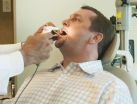Taking prescribed anti-clotting drug may help save stent patients' lives
American Heart Association Rapid Access Journal Report
2014-05-28
(Press-News.org) If you've just received a coronary artery stent to prop open a blood vessel, your life may depend on filling your prescription and taking an anti-clotting drug within days of leaving the hospital, according to a large study in the Journal of the American Heart Association.
The risk of heart attack and death is highest within the first 30 days for those who delay taking their medication than during long-term follow-up out to two years.
Taking the drug clopidogrel plus aspirin is advised for a month in people who have a bare metal stent implanted, and six to 12 months in patients who get a drug-eluting stent.
"It is very important that patients take clopidogrel after having a coronary stent implanted to prevent blood clots forming within the stent," said Nicholas Cruden, M.B.Ch.B., Ph.D., lead author and a consultant cardiologist at the Royal Infirmary of Edinburgh in the United Kingdom. "In a worst-case scenario, the stent can block, resulting in a heart attack or even death."
The new study is based on records for 15,629 people in British Columbia who received either type of stent in 2004-06. About 30 percent of the patients failed to fill a clopidogrel prescription within three days of leaving the hospital.
Compared to patients who filled their prescriptions promptly, those who delayed were about:
three times as likely to have a heart attack within a month;
five times as likely to die of any cause within a month; and
twice as likely to have a heart attack or to die of any cause within two years.
"This study highlights the importance of ensuring patients have access to medications as soon as they leave the hospital," Cruden said. "Even a delay of a day or two was associated with worse outcomes."
Discharging patients from the hospital with enough medicine for the highest-risk period — the first month or so — could help, he said.
INFORMATION:
Co-authors are: Jehangir N. Din, M.B.Ch.B., M.D.; Christian Janssen, Ph.D.; Reginald Smith, Ph.D.; J. David Hilton, M.D.; W. Peter Klinke, M.D.; Ron G. Carere, M.D.; Simon D. Robinson, M.B.Ch.B., M.D.; and Anthony Della Siega, M.D. Author disclosures are on the manuscript.
Additional Resources:
Follow AHA/ASA news on Twitter @HeartNews.
Anti-Clotting Agents Explained
Cardiac Procedures and Surgeries
Statements and conclusions of study authors published in American Heart Association scientific journals are solely those of the study authors and do not necessarily reflect the association's policy or position. The association makes no representation or guarantee as to their accuracy or reliability. The association receives funding primarily from individuals; foundations and corporations (including pharmaceutical, device manufacturers and other companies) also make donations and fund specific association programs and events. The association has strict policies to prevent these relationships from influencing the science content. Revenues from pharmaceutical and device corporations are available at http://www.heart.org/corporatefunding.
ELSE PRESS RELEASES FROM THIS DATE:
Black trauma patients 65 and older more likely to survive than white counterparts
2014-05-28
In a finding that runs counter to most health disparities research, Johns Hopkins researchers say that while younger black trauma patients are significantly more likely than whites to die from their injuries, black trauma patients over the age of 65 are 20 percent less likely to do so.
A report on the research appears online May 28 in JAMA Surgery.
"We have long found it vexing that minority patients consistently do worse, even in treatment for trauma that seems to leave little room for bias," says study leader Adil Haider, M.D., M.P.H., an associate professor of surgery ...
Demographic of heroin users change in past 50 years
2014-05-28
Bottom Line: Heroin users nowadays are predominantly white men and women in their late 20s living outside large urban areas who were first introduced to opioids through prescription drugs compared to the 1960s when heroin users tended to be young urban men whose opioid abuse started with heroin.
Authors: Theodore J. Cicero, Ph.D., of Washington University, St. Louis, and colleagues.
Background: Few studies on the demographics of present day heroin users have compared them to heroin users 40 to 50 years ago who were primarily young men from minority groups living ...
Study examines risk factors for sagging eyelids
2014-05-28
Bottom Line:
Other than aging, risk factors for sagging eyelids include being a man, having lighter skin color and having a higher body mass index (BMI).
Author:
Leonie C. Jacobs, M.D., Erasmus Medical Center, Rotterdam, the Netherlands, and colleagues.
Background:
Sagging eyelids because of excess skin (dermatochalasis) is typically seen in middle-age or older adults. Typically a cosmetic concern, sagging eyelids also can cause visual field loss, irritation and headaches because patients force themselves to elevate their brow in order to see better.
How ...
Survival after trauma related to race, age
2014-05-28
Bottom Line:
Race and age affect trauma outcomes in older and younger patients.
Author:
Caitlin W. Hicks, M.D., M.S., of the Johns Hopkins School of Medicine, Baltimore.
Background:
Disparities in survival after traumatic injury among minority and uninsured patients has been well described for younger patients. But information is lacking on the effect of race on trauma outcomes for older patients.
How the Study Was Conducted:
The authors examined in-hospital mortality after trauma for black and white patients between the ages of 16 and 64 years and 65 ...
Drug users switch to heroin because it's cheap, easy to get
2014-05-28
A nationwide survey indicates that heroin users are attracted to the drug not only for the "high" but because it is less expensive and easier to get than prescription painkillers.
Researchers at Washington University School of Medicine in St. Louis published the survey's results May 28 in the journal JAMA Psychiatry.
"In the past, heroin was a drug that introduced people to narcotics," said principal investigator Theodore J. Cicero, PhD. "But what we're seeing now is that most people using heroin begin with prescription painkillers such as OxyContin, Percocet or Vicodin, ...
The brain's reaction to male odor shifts at puberty in children with gender dysphoria
2014-05-28
The brains of children with gender dysphoria react to androstadienone, a musky-smelling steroid produced by men, in a way typical of their biological sex, but after puberty according to their experienced gender, finds a study for the first time in the open-access journal Frontiers in Endocrinology.
Around puberty, the testes of men start to produce androstadienone, a breakdown product of testosterone. Men release it in their sweat, especially from the armpits. Its only known function is to work like a pheromone: when women smell androstadienone, their mood tends to improve, ...
Mount Sinai researchers lead committee to define the clinical course of multiple sclerosis
2014-05-28
(NEW YORK – May 28) Accurate clinical course descriptions (phenotypes) of multiple sclerosis (MS) are important for communication, prognostication, design and recruitment for clinical trials, and treatment decision-making. Researchers at Icahn School of Medicine at Mount Sinai, part of the International Committee on Clinical Trials of MS, collaborated to re-examine the standardized MS clinical course descriptions originally published in 1996 and recommend refined phenotype descriptions that include improved clinical descriptive terminology, MRI and other imaging techniques, ...
NASA IceBridge concludes Arctic field campaign
2014-05-28
Researchers with NASA's Operation IceBridge have completed another successful Arctic field campaign. On May 23, NASA's P-3 research aircraft left Thule Air Base, Greenland, and returned to Wallops Flight Facility in Virginia marking the end of 11 weeks of polar research.
During this campaign, researchers collected data on Arctic sea and land ice – both repeating measurements on rapidly changing areas and expanding coverage into new, unsurveyed regions. The mission also released two sea ice data products and provided a professional development opportunity for three science ...
International collaboration highlights new mechanism explaining how cancer cells spread
2014-05-28
DALLAS – May 28, 2014 – UT Southwestern Medical Center cancer researchers have identified a protein critical to the spread of deadly cancer cells and determined how it works, paving the way for potential use in diagnosis and eventually possible therapeutic drugs to halt or slow the spread of cancer.
The protein, Aiolos, is produced by normal blood cells but commits a kind of "identity theft" of blood cells when expressed by cancer cells, allowing the latter to metastasize, or spread, to other parts of the body. Metastatic cancer cells have the ability to break free from ...
Suspect strep throat? Re-check negative rapid test results with lab culture
2014-05-28
Clinical guidelines conflict on testing teens and adults whose symptoms point to a possible strep throat. A chief contention is whether negative tests results from a rapid analysis of a throat swab, done in a doctor's office, should be confirmed through a follow-up laboratory culture.
The rapid test detects certain antigens, one of the body's efforts to fight off strep bacteria. Attempting to grow bacteria from a throat specimen double checks for the presence or absence of Group A Streptococcus bacteria, as well as a few other bacterial infections.
A study published ...
LAST 30 PRESS RELEASES:
Study: Teens use cellphones for an hour a day at school
After more than two years of war, Palestinian children are hungry, denied education and “like the living dead”
The untold story of life with Prader-Willi syndrome - according to the siblings who live it
How the parasite that ‘gave up sex’ found more hosts – and why its victory won’t last
When is it time to jump? The boiling frog problem of AI use in physics education
Twitter data reveals partisan divide in understanding why pollen season's getting worse
AI is quick but risky for updating old software
Revolutionizing biosecurity: new multi-omics framework to transform invasive species management
From ancient herb to modern medicine: new review unveils the multi-targeted healing potential of Borago officinalis
Building a global scientific community: Biological Diversity Journal announces dual recruitment of Editorial Board and Youth Editorial Board members
Microbes that break down antibiotics help protect ecosystems under drug pollution
Smart biochar that remembers pollutants offers a new way to clean water and recycle biomass
Rice genes matter more than domestication in shaping plant microbiomes
Ticking time bomb: Some farmers report as many as 70 tick encounters over a 6-month period
Turning garden and crop waste into plastics
Scientists discover ‘platypus galaxies’ in the early universe
Seeing thyroid cancer in a new light: when AI meets label-free imaging in the operating room
Neutrophil-to-lymphocyte ratio may aid risk stratification in depressive disorder
2026 Seismological Society of America Annual Meeting
AI-powered ECG analysis offers promising path for early detection of chronic obstructive pulmonary disease, says Mount Sinai researchers
GIMM uncovers flaws in lab-grown heart cells and paves the way for improved treatments
Cracking the evolutionary code of sleep
Medications could help the aging brain cope with surgery, memory impairment
Back pain linked to worse sleep years later in men over 65, according to study
CDC urges ‘shared decision-making’ on some childhood vaccines; many unclear about what that means
New research finds that an ‘equal treatment’ approach to economic opportunity advertising can backfire
Researchers create shape-shifting, self-navigating microparticles
Science army mobilizes to map US soil microbiome
Researchers develop new tools to turn grain crops into biosensors
Do supervised consumption sites bring increased crime? Study suggests that’s a myth
[Press-News.org] Taking prescribed anti-clotting drug may help save stent patients' livesAmerican Heart Association Rapid Access Journal Report



